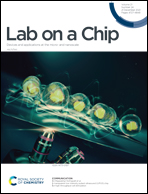3D microfluidic cloth-based analytical devices on a single piece of cloth by one-step laser hydrophilicity modification†
Abstract
In this work, we report for the first time a simple and robust method for constructing a 3D microfluidic analytical device on a single piece of hydrophobic cotton cloth. Specifically, laser scanning technology was applied to process hydrophilic regions at the top and bottom of a single piece of hydrophobic cloth. Symmetrical hydrophilic regions at the bottom and top constituted vertical microfluidic channels, and asymmetrical hydrophilic regions constituted transverse flow channels. Liquid flow velocity in 3D cloth-based microchannels can be adjusted flexibly by modifying laser parameters, and programmable laser scanning can be utilized to process 3D microfluidic devices with various patterns. Single-piece 3D cloth-based microfluidic devices formed via this method can be used in many fields such as information encryption and anti-counterfeiting, multi-liquid printing and liquid mixing dilution. Compared to traditional processing methods of 3D cloth-based microfluidic devices, the laser scanning method eliminates multiple complex and repetitive assembly processes, which is a significant advance in this research area. This processing method provides a new option for fast and large-scale manufacturing of 3D cloth-based microfluidic analysis devices for point-of-care testing application in undeveloped regions/countries.



 Please wait while we load your content...
Please wait while we load your content...